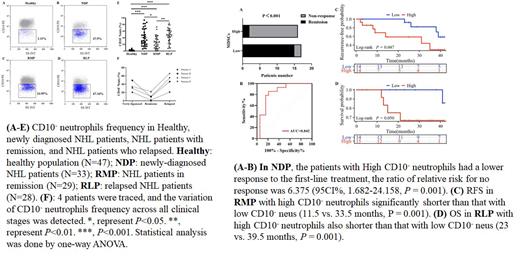Objectives: To explore CD10-CD14-CD45+HLA-DR+SSC++ neutrophils (CD10- neus) frequency in non-Hodgkins lymphoma (NHL) patients, and their immunologic characteristics and clinical significance. Methods: 90 NHL patients were involved, 47 age and gender-matched volunteers recruited as healthy controls (HC). The CD10- neus frequency in peripheral blood from the HC and NHL patients was detected. Then the CD10- and CD10+ neutrophils were isolated, and their morphologic characterization was compared. CD3+ T cells were also sorted for culture alone or co-culture with the autologous CD10+ or CD10- neutrophils for 48h, then the proliferation and viability of T cells were determined. The levels of Arg-1 and ROS in CD10+ or CD10- neutrophils were examined. Results: Little Few CD10- neus were detected in HC (1.94% ± 1.76), but the level was significantly elevated in newly diagnosed (NDP) and relapsed NHL patients (RLP), 37.90% ± 23.34 and 45.38% ± 20.89 respectively, there was a decrease in the remission patients (RMP, 26.62% ± 16.54). In NDP, CD10- neus at advanced stages was significantly higher than that at limited stages (50.16% ± 27.82 vs. 25.21±12.51, P = 0.017); similarly, the CD10- neus in patients with higher IPI score (3 to 5 points) more than that with lower IPI score (-2) group (53.94% ± 29.09 vs. 30.33 ± 17.73, P = 0.0154). According to the median value of CD10- neus, we further divided the patients into CD10- neus high or low two subgroups, the remission rate after 2 - 4 times first-line treatments in NDP with high CD10- neuts significantly lower than that in patients with low CD10- neuts (12.5% vs 88.24%, P = 0.001); the relapse free survival (RFS) in RMP with high CD10- neus significantly shorter than that with low CD10- neus (11.5 vs. 33.5 months, P = 0.001); the overall survive (OS) in RLP with high CD10- neus also shorter than that with low CD10- neus (23 vs. 39.5 months, P = 0.001). The CD10- neus from NHL mainly consisted of immature neutrophils, strong inhibited T-cell proliferation and viability, Arg-1 and ROS in CD10- neutrophils neuts vastly increased comparing to that from HC. Conclusions: CD10- neus in NHL have the two main characteristics of MDSCs cells (immature and T cell inhibition), the increased may predict disease progression and poor prognosis.
Disclosures
No relevant conflicts of interest to declare.


